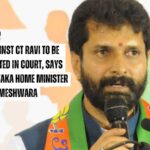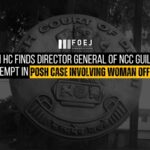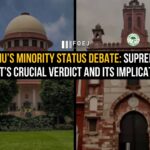The land that was much unknown in the pre-independence era rose to prominence post-partition. This land turned out to be the most bitterly contested terrain that was carefully built up by the communal forces in order to appropriate the stage for contemporary politics. The history behind this land is more mythological than factual; that stands up on the popular culture rather than the recorded history that further provided an antechamber to communal forces for manipulation and politicization. This land is none other than the one that recently culminated in its destination: the Ayodhya Ram Mandir.

The 22nd of January 2024 marked a black day on the grundnorm with the inauguration of Bhavya Mandir (grand temple) that has been built upon the ruins of minorities and their rights in India. The mandir, extending to an area of 2.7 acres with a built-up area of 57,400 sq ft, was inaugurated by the Hon’ble Prime Minister of the nation Shri Narendra Modi in the phenomenal Pran Pratishtha (consecration) ceremony to clearly substantiate the fulfillment of the long-standing dream of Ram Raj in the nation, which so far had largely been mythological.
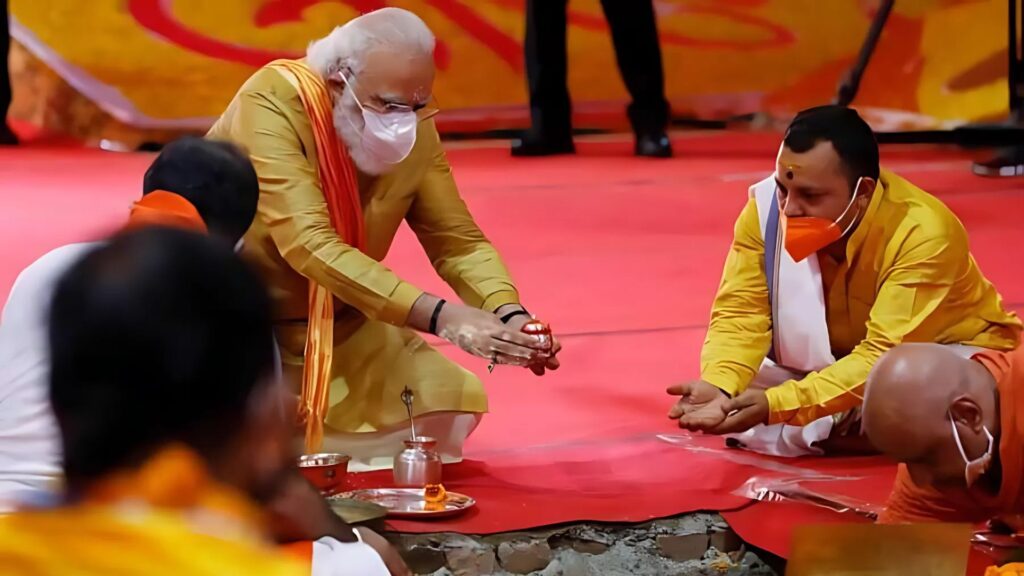
Tracing The History Of Myths
According to the Hindu calendar, the Ayodhya of Ram is believed to have existed some 900,000 years ago in Treta Yuga. According to traditional history, it was the capital of the Kosala Kingdom, and with the rise of Buddhism in the sixth and fifth centuries BC, it was displaced as the capital city. Some scholars agree that this Ayodhya was identical to Saketa, where Buddha is said to have resided for some time. It was rediscovered by ‘Vikramaditya’, who is identified by many scholars as Skandargupta of the mid-5th century, when Buddhism commenced to decline due to Brahmanical resurgence. Keeping aside all the contentions surrounding Ayodhya, it is one of the seven holy places of religious majority in India because of its association with Ram. Out of the 6,000 Hindu shrines in Ayodhya, more than 4,000 are connected with Ram. These religiously important instances, when coupled with the contemporary political significance, lead the religious majority population to conclude that the place is the center of their Hindu nationhood and their national leader, Lord Ram, without which their nationhood could not be absolute, just as there could not be Christendom without the Vatican of Europe.
The Location
The archaeological excavations on the right bank of the river Saryu in the Faizabad district of Uttar Pradesh reveal that “the earliest settlement at Ayodhya did not go back prior to the early stage of the Northern Black Polished Ware (NBPW) Culture,” which could be assigned to 700 BCE circa. Therefore, if the Ramayana episode was historical, it could not have taken place earlier than this period. With the conquest of the Mughals, it is believed that the Emperor Babar’s general, Mir Baqi, destroyed a Ram temple and had built Babri Masjid at its spot. As per the inscriptions on the site, it is said to have been constructed in around 935 of the Islamic Calendar, which is 1528–1529 CE. This mosque is believed to be one of the three mosques that were constructed on the order of Babur, the other two being in Panipat and Sambhal.
B. Lal, who initiated and headed an archaeological survey of the site in 1975, did not mention any evidence regarding the presence of temples or their remains at the site; however, it was only in October 1990 that he made a claim in the RSS magazine named Manthan that during the archaeological survey they discovered the pillar bases of a temple at the disputed site. Had the archaeological team really found anything at the site that necessitated it to keep such crucial facts a secret for yet another 15 years, or was it a planned political move so as to create an easy air for the associated national party? Another contention is raised by a scholar named Rajeev Saxena that how come the famous poet of that era, Tulsidas, who wrote on secular subjects and is widely known to have sung the glorious songs in praise of his beloved Ram, kept silent on the entire issue had there actually been a demolition at the site of the temple?
How It All Commenced: The Conflicts
1853-1855: The earliest incident of conflict between the two communities over the long-standing disputed site is recorded when Hinduism began to revive during the reign of Shuja ud Daula and Nawabs of Awadh and found its roots with the advent of the British in India. It was during this time that violent riots broke out in Ayodhya following the claims made by a Hindu sect, Nirmohi, then having their establishment at Ram Ghat, that the Babri Masjid stood over the ruins of an ancient temple, built over the Ram Janmabhoomi, that was destroyed by the Mughal Emperor, Babar.
1859: In order to ease the law and order situation and control the riots, the British Government conducted mediation, at the conclusion of which the disputed site was divided between the two communities. The inside area was allocated to the Muslims, while the outside was allocated to Hindus. The British referred to the mosque in their files as the ‘Janmasthan Mosque of Ajoodhia’ and had put up a notice board on the iron railings referring to the monument, wiwad grast.
1883: The permission to construct a temple on the platform (chabutra), in the outer area of the mosque on the left side of the gate, was declined by the then Deputy Commissioner of Faizabad in May 1883.

1885: A suit was filed by one Mahant Raghubar Das with the Sub-judge at Faizabad for permission to build the temple, which was turned down, and the following appeals were dismissed in 1886.

When the mosque was under the control of Muslim organizations, including the Waqf of that period, the mosque was quite neglected and mismanaged, especially during the period from 1910s to 1930s. However, things were silent and going fine until the idols magically appeared inside the premises of the mosque just two years after gaining independence from British rule.
1934—Communal riots were triggered in the area following the cow slaughter in a village named Shahjahanpur near Ayodhya in March 1934, during which a Hindu mob damaged the domes of Babri Masjid. However, the restoration work was carried out by the British Government at the expense of the public taxes.
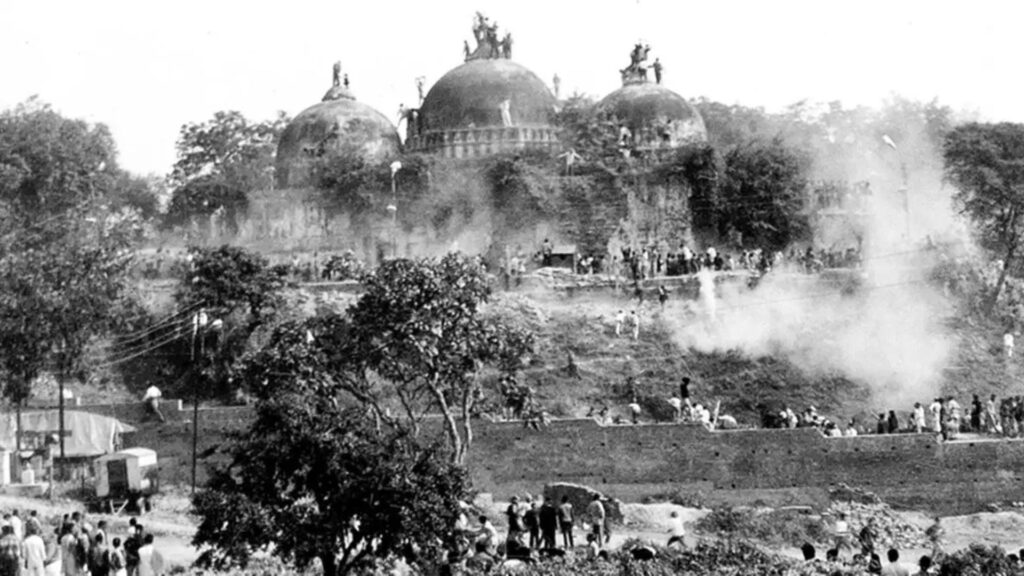
1949: The idols of Ram miraculously appeared inside the mosque on the intervening night of 22nd-23rd December 1949 as per the religious community, contrary to which the FIR recorded by the Station Officer of Ayodhya stated that three individuals along with the group of around 50 people trespassed the mosque’s premises and placed the idols inside, leading to the communal clashes in the area. Following the communal clashes, the area was locked, and the entrance was banned for every individual.
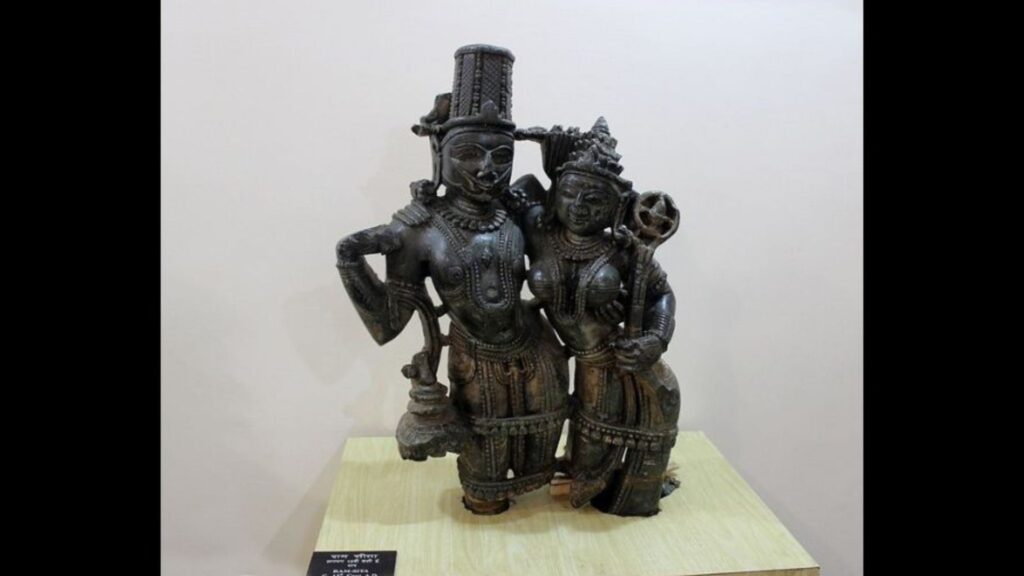
1950: Many civil suits were filed by the Hindu side, following which the Faizabad District Court granted them permission to conduct pooja in the area, and no interference was supposed to be caused in the same while the inner courtyard was supposed to remain closed.
Knitting Up The Stage
Things were quite dull for the period extending from 1950 to 1984, and no major political scandal or communal riots were witnessed. However, the period was an air of major developments taking place in Hindutva politics, which proved to be a calm before the storm that changed the political scenario in the country once and forever.
The first and foremost was the idea of an entry into mainstream politics to bring the long-standing dream to reality, and this idea was executed with the establishment of the Bharatiya Janata Party, the BJP, in 1980. Second was the formation of Sri Ram Janma Bhumi Mukti Yajya Samiti in 1984 by Mahant Avaidyanath to bring together all the Hindu organizations and sadhus for a greater cause. The samiti was formed with the purpose of opening Hindus about the Ram Temple construction at the disputed site, and as a first step towards the agenda, it organized a crucial Ram Janaki Rath Yatra (march) in October 1984 that commenced from Sitamari in Bihar and planned to end in Delhi as its final destination with Ayodhya in Uttar Pradesh in its sight, calling upon people to take the Janmsthan Mukti Pledge and vote for the party and leader that supports the construction of Bhavy Mandir (Grand Temple). Amid this, the Vishwa Hindu Parishad (VHP) constituted a group to kickstart the Ram Janmbhoomi Movement, of which the LK Advani was made the leader.
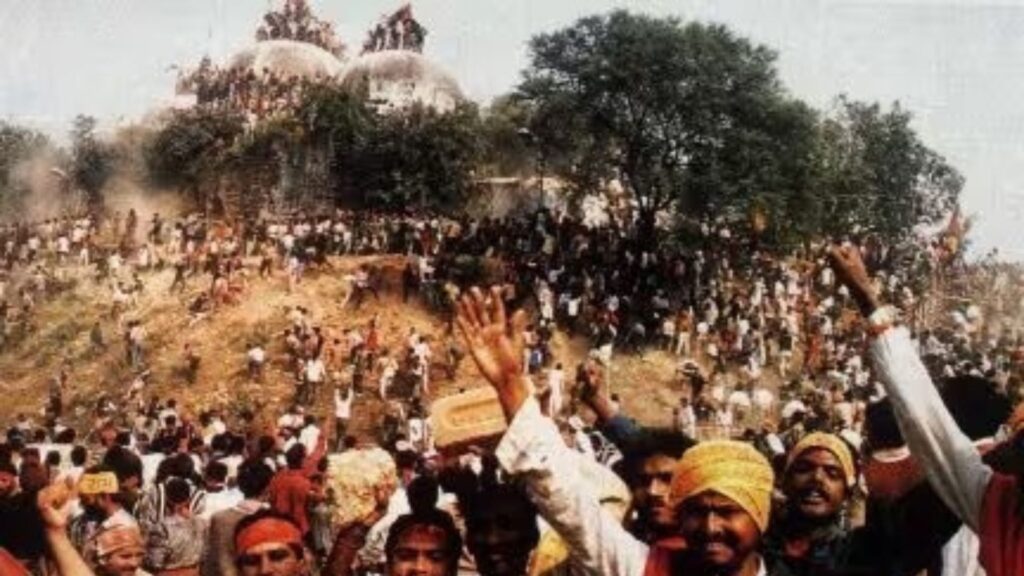
Temple Entry As Compensation
1986: The Muslim fundamentalism had already been given in following the Shah Bano controversy, so it was necessary for the then Prime Minister to neutralize the political air in view of the upcoming general elections. The Faizabad Court allowed the gates of the mosque, that were locked following the dispute of December 1949, to be thrown open so that the people could offer ‘pooja and perform darshan’ on the grounds that the orders for closure were given by the Faizabad District Administration and not by the Court earlier. However, everyone was barred from altering the nature of the structure until any further orders. Following this, an explosive situation had occurred across the nation as heavy criticism was seen from Muslims while equivalently lavish celebrations were witnessed from Hindus. As a sign of protest against the decision of district administration, Muslims constituted the Babri Mosque Action Committee (BMAC).
The Ayodhya Movement
1989: Opening of gates helped the extremist Hindu forces gain popularity for the movement and move ahead with the agenda of establishing the Bhavya Mandir (Grand Temple). The Sangh Parivar’s “National Thinkers Conferences” consolidated with the Palampur Resolution of June 1989 for the Ayodhya Movement at Palampur of Himachal Pradesh. It was conducted with the prime intention of inculcating the construction of Ram Temple as one of the major rallying points in the upcoming general elections. The resolution stated that as per the available records, the Mughal Emperor, Babar, had visited Ayodhya in 1528, where he destroyed a temple situated on the site where present-day Babari Masjid stands, which is believed to be the birth place of Lord Ram. Thus, a critical stage was developed when the preparations for the demolition of the mosque had begun ahead of the 1989 elections.
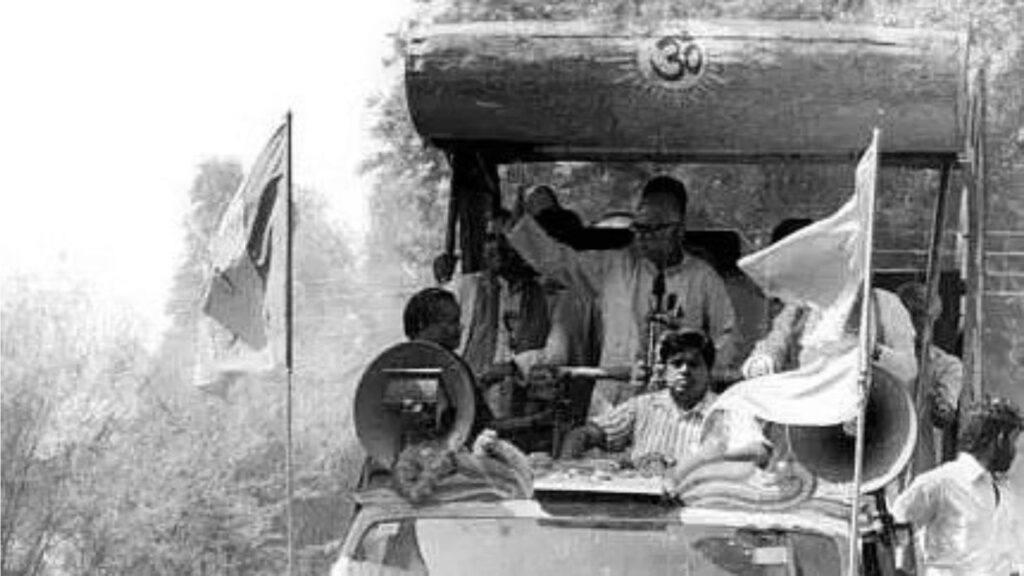
In a rally conducted on 22nd September, 1989, in Delhi, Mahant Avaidyanath announced that’shinalyas’ (laying down of the foundation stone) would be conducted on 9th November, 1989, by sadhus. In order to fuel the situation further, the desperate Rajiv Gandhi, in order to turn the air in his favor, allowed shinalyas’ ceremony to be conducted on the day announced earlier that year. The foundation stone for Ram Temple was laid down on November 9th, 1989, on the disputed site under Gandhi’s regime, thus further boosting the VHP-BJP-RSS ally to advance their Ram Janambhumi campaign. The elections of November 1989 reaped dividends for the BJP, and the tally for seats rose from 2 (in previous elections) to 86, with which it extended support to Vishwanath Pratap Singh (V. P. Singh) to form a government from the National Front of India.
V.P. Singh created a Special Bench to look into the matter of the disputed site and banned the construction at the site till the title was decided by the court. Meanwhile, all the civil suits pending before the courts were transferred to the Allahabad High Court. In the following year, the Supreme Court allowed the Hindu representatives to raise a preliminary issue before the Lucknow Bench of the Allahabad High Court that the suit filed by the Waqf Board was not maintainable. It was suggested to organize Dharmacharya Sammelan (gathering of religious heads) in order to guide the path for the disputed land.

1990 was the time when the Mandal Commission had submitted its report identifying the socially and educationally backward classes in India and recommending the path of reservation for their inclusion in government jobs and educational institutions. The RSS, son of Sangh Parivar, which largely consists of upper caste Hindus, had been demanding the BJP publicly denounce the Commission’s report, to which the party members did agree privately; however, they could not go public with the opinions for the sake of the party’s reputation and national support. On the other hand, the Vishwa Hindu Parishad had been desperate to commence the construction of Ram Temple and had announced 30th October as the appointed date for the purpose. At this time the then BJP leader, LK Advani came up with a perfect plan to fuel the Hindu population of the nation by announcing the infamous Rtah Yatra, or the chariot procession that would set for 10,000 km passing through 10 states, commencing from Somnath in Gujarat and destined to Ayodhya in Uttar Pradesh between September 25th and October 30th.
The Infamous Rath Yatra
In September 1990, LK Advani set out on his 10,000 km rathyatra (chariot procession) that would pass through 10 states commencing from Somnath in Gujarat to converge in Ayodhya for construction of the temple and to force the government to hand over the land to the Hindutva forces. The reason for choosing Somnath as the starting point, as per the BJP, was that it was at Somnath that the assault on Hindu religious places, as in temples and shrines, began by Islamic invaders in around 1026, when Mahmud Ghaznavi stepped in the present-day nation for the first time, plundering and ransacking the Somnath shrine. However, the spirit of Somnath could not be killed irrespective of the invasions. The temple was then rebuilt at the initiative of Sardar Patel in 1950 as a symbol of resurgent Indian nationhood. The reconstruction of the shrine was the first chapter in a journey aimed at preserving the old symbols of oneness, communal amity, and cultural unity. It was scheduled to conclude at Ayodhya to symbolize the liberation of Ram Janmabhumi as the second step in the journey.

On September 25th, 1990, the BJP chief of the time, L K Advani, kickstarted his Rath Yatra from Somnath with the intention to transverse across the country on a rath (in his case, a Toyota modified to look like a chariot) to build momentum for Ram Mandir construction. The yatra witnessed immense support from different sections of society, joined by many ‘activists’, and was marked by slogans and songs with a sole aim to galvanize Hindu support for the temple construction. Many journalists have described that herds of women lined up on either side of the road in Gujarat, Maharashtra and Madhya Pradesh with copper plates, ghee lamps, flowers, coins, etc. As a mark of ritual, these were thrown at Rath. It’s been reported that the rath got expensive offerings from the people along the way. Moreover, some people even stabbed their wrists and smeared the blood on Advani’s forehead as Tilak.
However, it smeared the blood of hundreds of innocents. He left a trail of violence from wherever he passed. The communal violence broke as he covered the miles further. As the procession was hindered and the leader was arrested in Bihar, it further intensified the communal violence across the nation. Hindu mobs attacked the Muslim localities, stopped the trains, pulled out, and killed those who were recognizably Muslims, reminiscing about the times of partition. As historian Ramachandra Guha noted in his book, India After Gandhi, “the imagery of the yatra was religious, allusive, militant, masculine, and anti-Muslim.” Around 166 communal incidents took place between September 1st and November 20th that killed around 546 people. The state of Uttar Pradesh witnessed the worst communal scenario killing 224 people.
However, the Yatra reaped its fruits for the organizers in the general elections of 1991, where the BJP secured 120 seats in the Parliament, second only to the Congress, and formed a government in Uttar Pradesh. The arrest of LK Advani in Bihar on orders of Lalu Prasad Yadav infuriated the party following the BJP withdrawing its support from the ruling party, which resulted in the falling down of the government. While suits were pending in the court, an attempt for negotiation was made by Chandra Shekahar in 1990, who was in power till March 1991, by bringing VHP and AIBMAC to the negotiation table, but in vain. In early 1992, the Hindu communalists announced their plan of demolishing the mosque in October of the same year, to which no action was taken by the administration.
The Demolition
On 6th December 1992, about 70,000 kar sevaks had assembled at the Ram Katha Kunj for a public meeting along with the 500 sadhus and sants at the foundational terrace for pooja. Between 11:45 and 11:50 a.m., around 150 kar sevaks managed to break the cordon on the terrace and pelted stones at police. A few minutes later, about 1,000 kar sevaks broke into the Babri Masjid structure, and around 80 of them managed to climb on the domes of the mosque and started to demolish it, while in the meantime, other kar sevaks had damaged the outer boundary wall. At around 12:20 p.m., about 25,000 kar sevaks had gathered in and around the complex, and by 2:40 p.m., a crowd of around 75,000 was surrounding the structure, who were engaged in demolition. The demolition of the centuries-old mosque leads to nationwide communal clashes between the two major religious groups of the country.
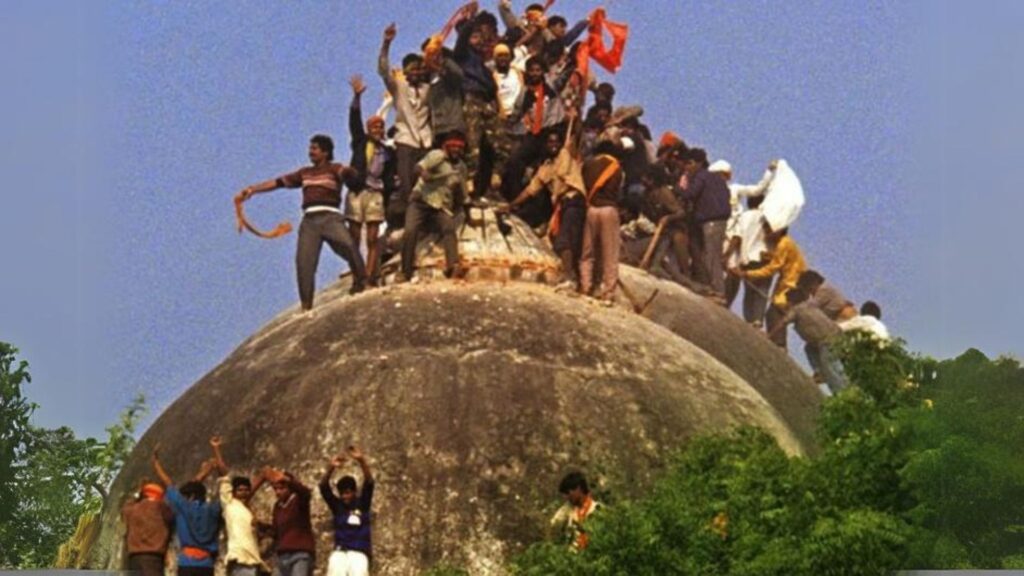
The aftermath of demolition witnessed a bloodbath as the nation was engulfed in religious hatred. Acid sling shots and lethal weapons came on screen, and immensely increased employment of ironsmiths who were asked by Hindu fanatics to make sharp weapons working round the clock. Infuriated by the demolition in Ayodhya, Muslims went onto the streets to protest, who succumbed to death either at the hands of Hindu mobs or happy policemen who were readily triggered at protestors. The police forces armed with handguns, sten guns, and rifles, if not actively firing at Muslim crowds, were passively involved by standing silent in league with the Hindu fanatic mob. 246 in Gujarat, 120 in Madhya Pradesh, 100 in Assam, 32 in West Bengal, 24 in Bihar, 201 in Uttar Pradesh, 48 in Rajasthan, 12 in Kerala, 60 in Karnataka, 12 in Andhra Pradesh, and 2 in Tamil Nadu (the lowest across the nation thanks to the restraint observed by the Muslim community along with the limited base of the BJP in the base contributed to the peaceful oasis of the state); these were the numbers that were reported by national media channels and newspapers; however, local news agencies claimed the numbers to be far higher, of which many went unreported.
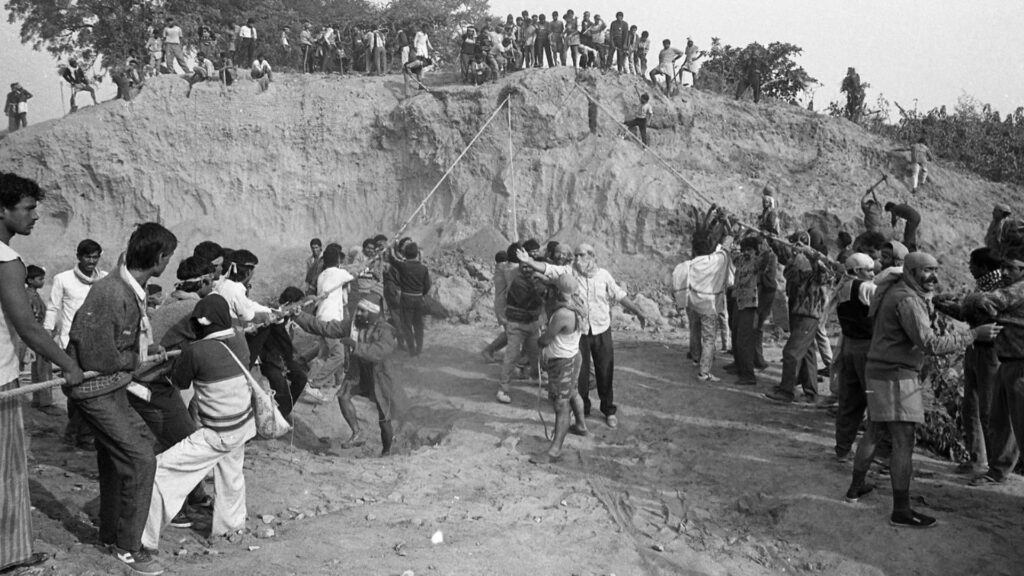
A continuous hate campaign by the RSS-BJP has been adding fuel to the otherwise quiet traders and businessmen. The tense atmosphere in Surat finally came to action following the mosque demolition, which provided organizations an opportunity to start riots leading to around 200 deaths, of which 95% were Muslims. The reports of the Justice Srikrishna Commission blamed Bal Thackrey, the then Shiv Sena chief, and Sena activists for the riots that took place in Bombay, as was then named. It highlighted their political role that fermented the communal disharmony and violence against Muslims. Further, it pointed out the Congress government’s inefficiency following conflicting orders issued multiple times that confused the police forces to shoot or not to shoot, resulting in 600+ deaths, mostly due to police firing on the Muslim community. Bloodletting had begun the day following as the news spread; however, it continued for days as the administration had been ghosting in the shadows with no will to stop the carnage. The rioters were further encouraged by the Sangh Parivar strom-troopers by openly brandishing weapons, to which the police remained a silent spectator.
On the other hand, following the demolition, cases were registered against L. K. Advani, Murli Manohar Joshi, and Uma Bharati of the Bharatiya Janata Party (all of whom later became central government ministers), Ashok Singhal and Vishnu Hari Dalmia of the VHP, and Vinay Katiyar of Bajrang Dal. All of them were arrested and remanded to judicial custody. Post the arrest, Advani added fuel to the situation by retorting, “When an old structure that ceased to be a mosque over 50 years ago is pulled down by a group of people exasperated by the tardiness of the judicial process and the obtuseness and myopia of the executive, they are reviled by the President, the Vice President, and political parties as betrayers of the nation, destroyers of the constitution, and what not! … I wish to caution the government against this approach. Their pronouncements against kar sevaks are only strengthening the movement.” Henceforth, it’s evident that the demolition of Babri Masjid was part of the Ayodhya movement.
Further, the Liberhan Commission to investigate the matter was created by the then Central Government; it was a one-man commission headed by a retired High Court Judge, Manmohan Singh Liberhan. Formed by the orders of the then Union Home Ministry on 16th December 1992 following the demolition on 6th December and the subsequent riots, it has been the longest running inquiry commission in the history of Independent India that witnessed 399 sittings and 48 extensions over the course of 16 years. The commission finally submitted its report on June 30th,tated, “The factual matrix also yields indisputable evidence that lured by the prospect of power or wealth, a rank of leaders emerged within the BJP, RSS, VHP, Shiv Sena, Bajrang Dal, etc. who were neither guided by any ideology nor imbued with any dogma nor restrained by any moral trepidation. 2009, to the then Prime Minister Manmohan Singh, recommending the formation of a law that would severely punish the misuse of religion for political agendas, further it found that the demolition of Babri Masjid was systematic and planned to create an environment of religious intolerance for political gains. It stated, “The factual matrix also yields indisputable evidence that lured by the prospect of power or wealth, a rank of leaders emerged within the BJP, RSS, VHP, Shiv Sena, Bajrang Dal, etc. who were neither guided by any ideology nor imbued with any dogma nor restrained by any moral trepidation. These leaders saw the “Ayodhya Issue” as their road to success and sped down this highway mindless of the casualties they scattered about. These were the executioners wielding the sword handed to them by the ieologues.”
In an attempt to control the situation to a certain extent, a belated step was taken by the government by promulgating the Acquisition of Certain Areas at Ayodhya Act, 1993, that later was passed as law, in order to maintain the status quo of the debris of the now demolished historic Babri Masjid. The promulgation, among other things, further stipulated that the disputed land would be handed over to a trust that would be created after this Act had been promulgated. The decision was upheld by the Supreme Court in October 1994, in the infamous Ismail Farooqui v. Union of India, to acquire the disputed 67acres acres cited while stating that every religious immovable property is liable to be acquired by the state, for the reasons that could be specified at the time of such acquisition. The Apex Court further adjudged that offering namaz at a mosque was not an integral part of Islam unless that mosque held any particular significance in Islam. Further, it enabled Hindus to worship on the disputed land on the basis of the ‘comparative user principle’ (i.e., the Muslims were praying less often than the Hindus before the mosque was demolished). The judgment was heavily criticized for regarding the mosque as not an integral part of Islam and a non-essential place of worship; however, no reviews or appeals against the judgment were filed. The decision, thus, revived the proceeding that was pending in the Allahabad High Court to decide Muslims’s right to worship in the disputed area.
The Legal Battle
July 1996: The Lucknow Bench of Allahabad High Court began recording the oral evidence related to the Ayodhya title dispute case hearing.
October 2002: The High Court ordered the Archaeological Survey of India to carry out a scientific investigation and survey of the disputed site by using ground-penetrating technology, or geo-radiology.
March 2003: The Allahabad High Court orders the Archaeological Survey of India to excavate the disputed site and look for evidence of the previous structure, if any. The ASI submits its report in August of the same year, claiming to have discovered the remnants of a 10th-century Hindu temple at the site, to which questions were raised by the Muslim side.
June 2009: Meanwhile, the single manned commission created on 16th December 1992 to investigate the demolition of Babri Masjid and the subsequent riots submitted its report with a delay of 17 years, as the commission was initially ordered to complete the probe within three months; however, adjournments were provided 48 times since its inception.
September 30th, 2010: The Allahabad High Court delivered its judgment in which it divides the land among the three contesting parties, namely Ram Lalla, Nirmohi Akhara, and the Sunni Waqf Board, holding that the Hindus as well as the Muslims were the joint holders of the disputed site. The major area beneath the main dome of the mosque, where the temple stands today, was given to Ram Lalla, while Nirmohi Akhara was awarded with the nearby Ram Chabutra and Sita Rasoi. The one-third received by the Sunni Waqf Board comprised the outer courtyard of the disputed area. The decision of the court was criticized as it gave another dimension to the matter as none of the parties prayed for the division of the land, and therefore the matter was required to be stayed by the court.
May 2011: The Supreme Court stayed the decision given by the Allahabad High Court, calling it unusual as none of the parties demanded the decree of partition in the matter, and thus, it was strange to pass such an order.
August 2017: The 3 judge bench of the Apex Court starts hearing the matter. In which the petitioners argue that the court should reconsider the judgment given in the Ismail Farooqui matter in 1994 by referring it to 7 judge benches.
July–SSeptember 2018: The Supreme Court reserves its judgment on the point of reconsideration of Ismail Farooqui Judgment, to which it later refuses the need to refer the matter for reconsideration to a larger bench.
January to August, 2019: Using his administrative powers, CJI Ranjan Gogoi formed a Constitutional Bench comprising five judges to decide upon the disputed matter. In February of the same year, the parties were referred to mediation, which went inconclusive with an unbinding partial agreement as all the parties did not agree to the same point, following which the Supreme Court commenced the hearings of the matter in August 2019.
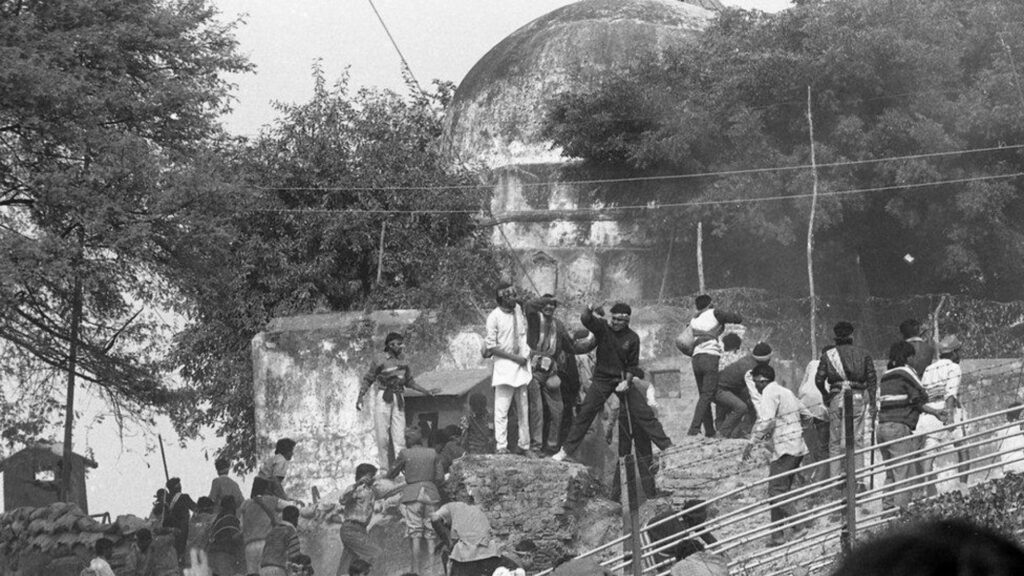
November 2019: The Apex Court gave its verdict over the long-standing dispute of Ram Janmabhoomi-Babri Masjid, awarding the title of disputed site to Shri Ram Virajman, further directing the state to grant 5 acres of land to the Sunni Waqf Board within the prominent area so as to compensate for the loss felt by the community. Relying on the report submitted by the Archaeological Survey of India, the judgment stated that Babri Masjid was not constructed on the vacant land and the structure that existed beneath it was non-Islamic in nature; however, whether it was a temple or not is still unclear. The demolition was utterly the violation of law, but the judgments could not solely be based on faith and trust and needed legal backing.
The judgment was based on the three major principles as stated by the senior Supreme Court judges in an anonymous and unanimous judgment. First and foremost, the apex court followed the constitutional principle of equality before the law and used the ‘evidence of actual worship down the centuries’ to give Hindus possession of the disputed site, while on the other hand it evoked the moral principle of ‘equity’ under Article 142 to grant 5 acres of the land in premises to the Muslim side. Secondly, the continuous worship by the Hindus at the site, traced back to even before the construction of the mosque subsequently to present time had always been in belief that the site is Janamsthan of Lord Ram, which had been supported by documentary and oral evidence. Thirdly, the UP Sunni Waqf Board was unable to provide clear evidence as to its continuous and interrupted usage of the land from the past three decades, nor was it able to prove that namaz was being offered at the place since the inception of the mosque; thus, the question of adverse possession had been dismissed by the Apex Court. Albeit judgment was given in favor of Hindu community, the court regarded the act of placing idols inside the mosque as ‘the act of desecration’ and pulling down the mosque as ‘illegal’.
Following this, approximately a year later, in August 2020, the Hon’ble Prime Minister Shri Narendra Modi laid the foundation stone of Ram Mandir. Following which the construction had begun to establish a cultural, religious, and spiritual hub at Ayodhya. The three-story temple has been constructed in Nagara style temple architecture using exclusive materials like:
o Bansi Paharpur Pink Sandstone from Bharatpur, Rajasthan for main structure;
o Granite stones in plinths;
o White Makrana and Colore Marble for inlay work;
Teakwood for constructing doors;
o Special bricks named ‘Ram Shilas‘ with ‘Shri Ram’ inscribed on each of them;
o 60million (as estimated) Shaligram Rock has been used to structure the idols, specially brought from Gandaki river in Nepal;
o Ashtdhadu (meaning eight things) comprising Gold, Silver, Copper, Zinc, Lead, Tin, Iron, and Mercury have been in the making of a grand bell that weighs around 2100kg and the sound of which could be heard to as far as 15kms; to name a few.
A remarkable feature of the temple is that no iron or steel is used in its construction. The aforementioned material has been meticulously used to make the temple last for more than 1000 years, contrasting to the life span of steel or iron, which is only 70–80 years, ensuring its long standing against every odd or natural calamity, thus making it ‘earthquake proof’. Another remarkable feature of the temple is the ‘time capsule’ that has been placed approximately 2000 feet beneath the ground right under the temple, with a copper plate containing inscriptions of relevant information about Ayodhya, Ram, and Ram Mandir, with the purpose of keeping the identity of the mandir intact and unforgettable.

The construction of the temple has indeed been an unforgettable moment for every single individual of the country; for some it has been a moment of utter happiness, while for others it has been a mark on their secondary status in the nation. As the inauguration of the most-awaited architectural structure in India was scheduled for January 2024, only the ground floor where the Ram Lalla idol had been installed was opened for public visit. Another chance was used by the ruling party to gain support and freshen the fading memories of the Ayoodhya issue by inaugurating the temple just a few weeks ahead of the General Lok Sabha elections 2024, even when the construction was still incomplete and was claimed to be completed by December 2024 only.

